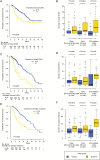Prognostic relevance of genetic alterations in diffuse lower-grade gliomas
- PMID: 29016839
- PMCID: PMC5761527
- DOI: 10.1093/neuonc/nox132
Prognostic relevance of genetic alterations in diffuse lower-grade gliomas
Abstract
Background: Diffuse lower-grade gliomas (LGGs) are genetically classified into 3 distinct subtypes based on isocitrate dehydrogenase (IDH) mutation status and codeletion of chromosome 1p and 19q (1p/19q). However, the subtype-specific effects of additional genetic lesions on survival are largely unknown.
Methods: Using Cox proportional hazards regression modeling, we investigated the subtype-specific effects of genetic alterations and clinicopathological factors on survival in each LGG subtype, in a Japanese cohort of LGG cases fully genotyped for driver mutations and copy number variations associated with LGGs (n = 308). The results were validated using a dataset from 414 LGG cases available from The Cancer Genome Atlas (TCGA).
Results: In Oligodendroglioma, IDH-mutant and 1p/19q codeleted, NOTCH1 mutations (P = 0.0041) and incomplete resection (P = 0.0019) were significantly associated with shorter survival. In Astrocytoma, IDH-mutant, PIK3R1 mutations (P = 0.0014) and altered retinoblastoma pathway genes (RB1, CDKN2A, and CDK4) (P = 0.013) were independent predictors of poor survival. In IDH-wildtype LGGs, co-occurrence of 7p gain, 10q loss, mutation in the TERT promoter (P = 0.024), and grade III histology (P < 0.0001) independently predicted poor survival. IDH-wildtype LGGs without any of these factors were diagnosed at a younger age (P = 0.042), and were less likely to have genetic lesions characteristic of glioblastoma, in comparison with other IDH-wildtype LGGs, suggesting that they likely represented biologically different subtypes. These results were largely confirmed in the cohort of TCGA.
Conclusions: Subtype-specific genetic lesions can be used to stratify patients within each LGG subtype. enabling better prognostication and management.
Keywords: diffuse lower-grade glioma; genetic alteration; prognostic factor.
© The Author(s) 2017. Published by Oxford University Press on behalf of the Society for Neuro-Oncology. All rights reserved. For permissions, please e-mail: journals.permissions@oup.com
Figures



References
-
- Louis DN, Perry A, Reifenberger G et al. . The 2016 World Health Organization classification of tumors of the central nervous system: a summary. Acta Neuropathol. 2016;131(6):803–820. - PubMed
-
- Suzuki H, Aoki K, Chiba K et al. . Mutational landscape and clonal architecture in grade II and III gliomas. Nat Genet. 2015;47(5):458–468. - PubMed
-
- Ohgaki H, Kleihues P. Genetic profile of astrocytic and oligodendroglial gliomas. Brain Tumor Pathol. 2011;28(3):177–183. - PubMed
-
- Smith JS, Perry A, Borell TJ et al. . Alterations of chromosome arms 1p and 19q as predictors of survival in oligodendrogliomas, astrocytomas, and mixed oligoastrocytomas. J Clin Oncol. 2000;18(3):636–645. - PubMed
Publication types
MeSH terms
Substances
LinkOut - more resources
Full Text Sources
Other Literature Sources
Medical
Miscellaneous

